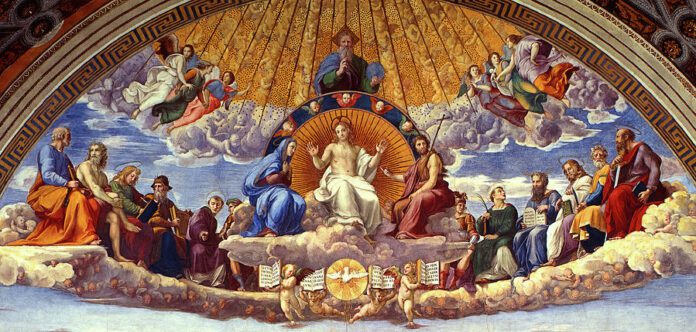Raphael’s prodigiousness in painting – despite his relatively short life – was a result of his training that began when he was just a mere child. From a childhood spent in his painter father’s workshop to his adult life running one of the largest workshops of its kind, he garnered a reputation as one of the most productive artists of his time.
The serene and harmonious qualities of Raphael’s paintings were regarded as some of the highest models of the humanist impetus of the time, which sought to explore man’s importance in the world through artwork that emphasized supreme beauty.
Raphael not only mastered the signature techniques of High Renaissance art such as sfumato, perspective, precise anatomical correctness, and authentic emotionality and expression, he also incorporated an individual style noted for its clarity, rich color, effortless composition, and grandeur that was distinctly his own.
Although largely known for his paintings, many of which can still be seen in the Vatican Palace where the frescoed Raphael Rooms were the largest work of his career, he was also an architect, printmaker, and expert draftsman. In other words, a true “Renaissance man.”

This fresco in the Stanza della Segnatura, one of the four Raphael Rooms in the Apostolic Palace in the Vatican, is one of four paintings in the room which depict separately: philosophy, poetry, theology, and law. The Disputation of the Holy Sacrament represents theology and shows the occupants of a Catholic Church underneath the span of heaven above their sacred altar. The fresco represents Christianity’s victory over Philosophy, which is depicted in The School of Athens, the fresco on the opposite wall.
In heaven we see Christ in the center with the Virgin Mary on his right and John the Baptist on his left. God the Father is shown reigning over heaven above Jesus, with Adam to his left, and Jacob to his right. Moses is seen holding the tablets with the ten commandments, and the Holy Spirit is shown at the feet of Jesus. On either side of the Holy Spirit are the four gospels held by cherubs.
On earth are theologians. The original four Doctors of the Church, a title given to Saint Augustine, Pope Gregory I, Saint Jerome, and Saint Ambrose, named in their halos, are seen debating the Transubstantiation; the miraculous conversion of the eucharistic elements at their consecration into the body and blood of Christ in the earthly form of bread and wine. St Augustine and St Ambrose are seated to the right of the altar and Pope Gregory I and St Jerome to the left. Also present are Pope Julius II, Pope Sixtus IV, Savonarola, and Dante. All together this fresco depicts over 100 figures. In Raphael’s rendition The Disputation takes on more than a depiction of the Eucharist. Instead, it becomes a dynamic search by theologians for the truth embodied in the mystery of the Eucharist.
This fresco, painted when Raphael was only 27 years old, represents his first significant commission to redecorate what were to become Pope Julius II’s private apartments. Unfortunately, it involved painting over frescos by other important Renaissance painters including Piero della Francesca and Raphael’s teacher Perugino. The Stanza della Segnatura was used by Julius II as a library and private office and takes its name from its use later in the sixteenth century as the highest court of the Holy See presided over by the pontiff Segnatura Gratiae et Ilustitiae.
Raphael won the commission to paint the four rooms in direct competition with both Michelangelo, who was at the time working on the Sistine Chapel, and Leonardo da Vinci. This is said to have incensed Michelangelo who would later accuse Raphael of plagiarism, spreading rumors that Raphael had stolen into the Sistine Chapel to have a sneak preview of Michelangelo’s work. The source of the animosity was however probably no more than that of competition between two extremely talented professionals vying for the favor of the same client.
Fresco – Vatican City
Source: https://www.theartstory.org




